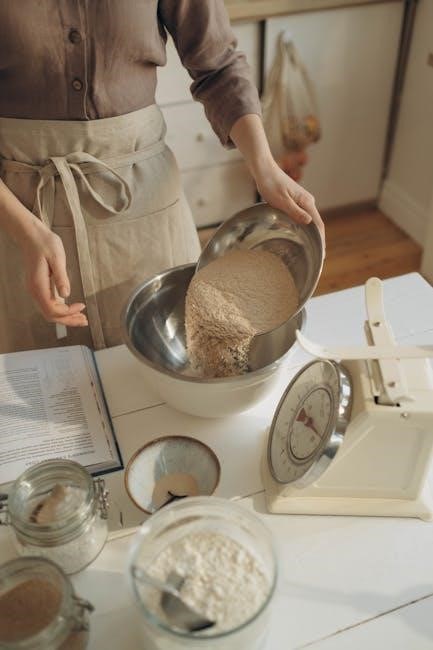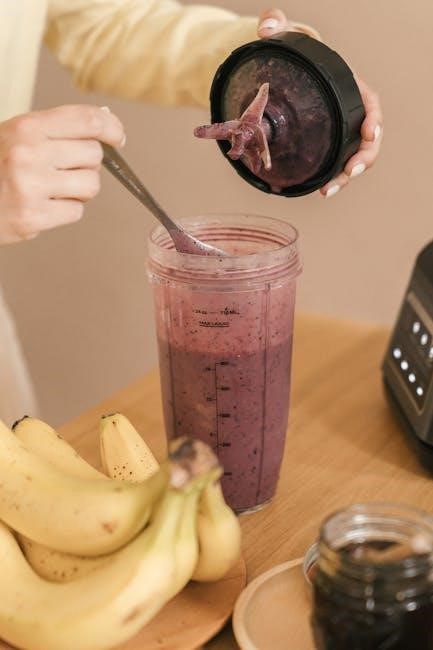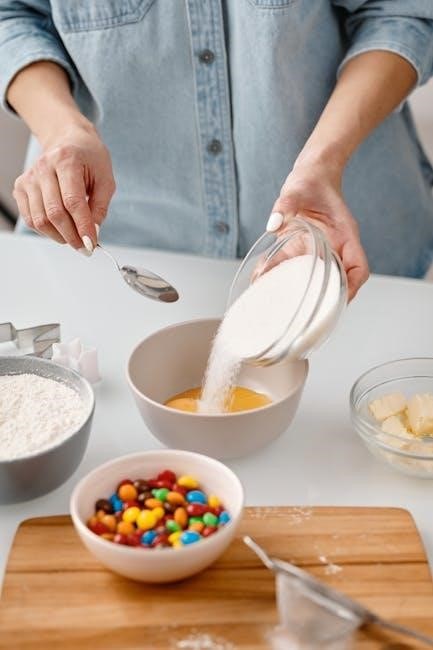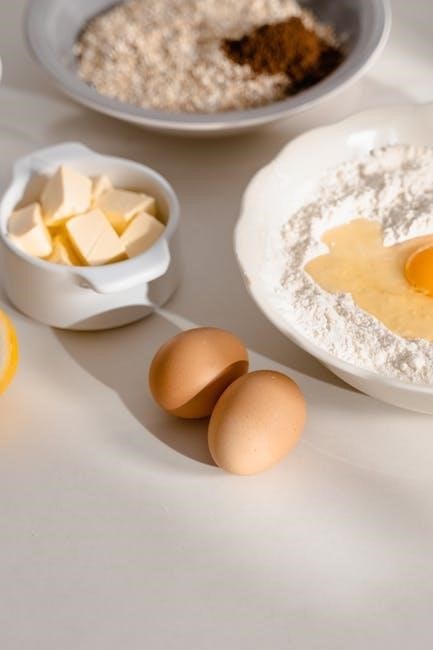Permethrin 13․3 is a potent insecticide concentrate used for treating clothing‚ gear‚ and surfaces to repel ticks‚ mosquitoes‚ and other pests․ It ensures long-lasting protection when applied correctly․
1․1 What is Permethrin 13․3?
Permethrin 13․3 is a concentrated insecticide solution containing 13․3% permethrin‚ an active ingredient that repels and kills insects like ticks‚ mosquitoes‚ and mites․ It is commonly used for treating clothing‚ gear‚ and surfaces to provide long-lasting protection against insect bites․ The solution is designed to bond with fabrics‚ ensuring durability through multiple washes and exposures to sunlight․ While it is highly effective‚ it is important to follow proper mixing and application instructions to ensure safety and efficacy․ Permethrin 13․3 is not intended for direct application on skin or animals‚ and proper precautions should be taken to avoid exposure during mixing and application․
1․2 Uses of Permethrin 13․3
Permethrin 13․3 is primarily used to treat clothing‚ outdoor gear‚ and surfaces for insect control․ It is effective against ticks‚ mosquitoes‚ mites‚ and other pests‚ making it ideal for preventing diseases like Lyme disease and Zika virus․ The solution can be applied to fabrics such as uniforms‚ camping gear‚ and pet areas․ It is also used in agricultural settings to protect livestock from pests․ When properly mixed and applied‚ Permethrin 13․3 provides a residual effect‚ offering protection for up to six weeks or six washes․ It is a versatile and reliable option for both personal and professional pest management needs‚ ensuring safety when used as directed․

1․3 Importance of Proper Mixing
Proper mixing of Permethrin 13․3 is crucial for ensuring its effectiveness and safety․ Incorrect dilution can lead to under-application‚ reducing pest control efficacy‚ or over-application‚ posing risks to humans‚ pets‚ and the environment․ Following the recommended mixing ratios ensures the solution reaches the optimal concentration for targeting pests while minimizing potential hazards․ Proper mixing also prevents separation or uneven distribution of the active ingredient‚ maintaining the product’s integrity․ This step is vital for achieving consistent‚ long-lasting protection against insects and ensuring the solution adheres to safety standards․ Always refer to the product label for precise guidelines to avoid errors and guarantee effective results․

Safety Precautions
Wear PPE‚ including gloves and goggles‚ when mixing or applying Permethrin 13․3․ Keep away from pets‚ livestock‚ and water sources to avoid contamination and potential harm․
2․1 Personal Protective Equipment (PPE)
When handling Permethrin 13․3‚ wear appropriate PPE to minimize exposure․ Use long sleeves‚ closed-toe shoes‚ and chemical-resistant gloves to prevent skin contact․ Goggles or safety glasses protect the eyes from splashes․ A face mask reduces inhalation risks․ Ensure all clothing is washed after use and PPE is disposed of properly․ Avoid eating‚ drinking‚ or smoking during application․ Always follow the manufacturer’s guidelines for PPE to ensure safe handling and mixing of the product․
2․2 Handling and Storage Safety
Handle Permethrin 13․3 with care to avoid accidents․ Store the product in a cool‚ dry‚ well-ventilated area away from children‚ pets‚ and flammable materials․ Keep the original container tightly sealed and label it clearly․ Avoid storing near food‚ water‚ or feed supplies․ Prevent contamination of water sources‚ as Permethrin is toxic to aquatic life․ Dispose of unused product and containers according to local regulations․ Ensure the area is ventilated during handling to prevent inhalation of fumes․ Follow all label instructions for safe storage and disposal to protect human health and the environment․

Mixing Ratios for Permethrin 13․3
Permethrin 13․3 is mixed at dilution rates of 0․25 to 0․50 percent for most applications․ Typically‚ 2 2/3 to 5 1/2 ounces are added per gallon of water․
3․1 General Dilution Rates
Permethrin 13․3 is typically mixed at a 0․25 to 0․50 percent dilution rate for most applications․ This means adding 2 2/3 to 5 1/2 ounces of concentrate per gallon of water․ The exact ratio depends on the intended use‚ such as tick control or general pest management․ For example‚ 0․25 percent is often sufficient for general pest control‚ while 0․50 percent is recommended for heavier infestations or longer-lasting protection․ Always measure the concentrate accurately to ensure the correct dilution․ Following the product label instructions is crucial for safety and effectiveness․ Proper mixing ensures the solution adheres to surfaces or fabrics effectively‚ providing reliable insecticidal properties․
3․2 Ounces per Gallon of Water
For most applications‚ Permethrin 13;3 is mixed at a rate of 2 2/3 to 5 1/2 ounces of concentrate per gallon of water․ This range allows flexibility depending on the intended use‚ such as tick control or general pest management․ The lower end (2 2/3 ounces) is often used for general pest prevention‚ while the higher end (5 1/2 ounces) is reserved for heavier infestations or surfaces requiring longer-lasting protection․ Accurate measurement is critical to ensure the solution’s effectiveness and safety․ Always follow the product label for specific guidance‚ as improper mixing can reduce efficacy or pose risks․ Proper dilution ensures the solution adheres effectively to surfaces or fabrics‚ delivering reliable insecticidal results․
3․3 Application-Specific Ratios
Application-specific ratios for Permethrin 13․3 vary based on the target use․ For treating clothing‚ a 0․5% solution is standard‚ achieved by mixing 1 part concentrate with 199 parts water․ This ratio ensures fabric safety and efficacy․ For agricultural or livestock applications‚ higher concentrations may be required‚ typically ranging from 0․25% to 1․0%‚ depending on pest severity․ Always consult the product label for precise guidelines‚ as incorrect dilution can lead to reduced effectiveness or potential harm․ Adjustments may also be necessary for specific insect types or environmental conditions‚ ensuring optimal results while minimizing risks to people‚ animals‚ and the environment․ Proper calibration is key to achieving desired outcomes safely and effectively․

Step-by-Step Mixing Instructions
Start by preparing a clean mixing area․ Measure the recommended amount of Permethrin 13․3 concentrate using the provided chart․ Gradually add it to water‚ stirring thoroughly to ensure even distribution․ Allow the mixture to sit briefly before transferring to a spray tank or storage container․ Always follow the product label for precise instructions and safety guidelines․
4․1 Preparing the Mixing Area
Before mixing Permethrin 13․3‚ ensure the area is clean‚ well-ventilated‚ and free from clutter․ Wear appropriate Personal Protective Equipment (PPE)‚ including gloves‚ goggles‚ and a mask․ Cover surfaces with plastic or drop cloths to prevent accidental spills․ Keep water and a neutralizing agent nearby in case of emergencies․ Ensure no food‚ pets‚ or livestock are in the vicinity․ Double-check that all containers are properly labeled and sealed․ Verify the availability of measuring tools and mixing equipment․ A well-prepared area minimizes risks and ensures safe‚ efficient mixing of the permethrin solution․ Always follow the manufacturer’s guidelines for optimal safety and effectiveness․
4․2 Measuring the Concentrate
Accurate measurement of Permethrin 13․3 concentrate is crucial for effective and safe use․ Always refer to the product label for specific dilution rates‚ typically ranging from 0․25% to 0․50%․ Use the provided measuring cup or a calibrated tool to pour the required amount of concentrate‚ such as 2 2/3 to 5 1/2 ounces per gallon of water․ Avoid overpouring by gently trickling the concentrate into the measuring device․ Handle the concentrate carefully‚ as it can stain surfaces or cause skin irritation․ Ensure the area is well-lit to prevent spills and mix in a well-ventilated space․ Double-check the measurements before adding water to maintain the correct ratio and avoid contamination․ Proper measurement ensures the solution is effective and safe for intended use․
4․3 Adding Water and Mixing
After measuring the concentrate‚ slowly add water to the mixing container while gently stirring to avoid splashing․ Use clean‚ cold water for optimal emulsion formation․ Continue stirring until the mixture is uniform‚ ensuring the concentrate dissolves completely․ For large batches‚ a mechanical agitator or whisk may be necessary to prevent separation․ Avoid adding water too quickly‚ as this can prevent proper mixing․ Once combined‚ inspect the solution for clarity and consistency․ If sediment remains‚ continue mixing until fully incorporated․ Proper mixing ensures even distribution of the active ingredient‚ maximizing effectiveness and preventing residue buildup on treated surfaces or fabrics․ Store any leftover solution in a sealed‚ labeled container following safety guidelines․

Application Methods
Permethrin 13․3 can be applied via spraying for quick treatment or soaking for thorough coverage․ Both methods ensure effective pest control and lasting protection on surfaces and fabrics․
5․1 Spraying
Spraying is a convenient method for applying Permethrin 13․3‚ ideal for treating individual items or small batches․ Use a spray bottle or handheld sprayer‚ ensuring even coverage․ Shake the solution thoroughly to maintain consistency․ Apply the spray evenly to all surfaces‚ especially areas prone to insect contact․ Avoid over-saturation‚ as it may lead to runoff․ Allow the treated items to air dry in a shaded‚ well-ventilated area to prevent degradation from sunlight․ Spraying is less time-consuming than soaking but may require reapplication after washing or exposure to heavy wear․ Always follow the recommended dilution rates for optimal effectiveness and safety․
5․2 Soaking
Soaking is a thorough method for treating clothing and gear with Permethrin 13․3‚ especially useful for bulky items or large quantities․ Submerge items in a solution mixed at the recommended 0․5% concentration․ Use a bucket or individual bags to ensure even saturation․ Allow the items to soak for several hours to maximize penetration․ After soaking‚ remove items and let them air dry in the shade to prevent Permethrin degradation․ Soaking ensures comprehensive coverage‚ including the inside of fabrics‚ enhancing protection against insects․ This method is ideal for extended durability‚ lasting up to six weeks or six washes‚ making it a preferred choice for outdoor enthusiasts and those in high-risk areas․
5;3 Choosing the Right Method
Selecting between spraying and soaking depends on the number of items and desired convenience; Spraying suits small-scale applications‚ offering quick treatment for individual items․ Soaking is more efficient for bulk items‚ ensuring thorough coverage․ Consider fabric type‚ treatment duration needs‚ and personal preference․ Both methods provide effective protection‚ but soaking offers deeper penetration‚ enhancing insect resistance․ Choose the method that best fits your gear and situation for optimal results․ Proper application ensures safety and efficacy‚ adhering to manufacturer guidelines for concentration and drying times․ This balanced approach ensures effective pest control while maintaining fabric integrity and user convenience․

Treating Clothing and Gear
Permethrin 13;3 effectively repels ticks and insects when applied to clothing and gear․ It provides long-lasting protection‚ remaining active for up to 6 washes or weeks․
6․1 Fabric Types Suitable for Treatment
Permethrin 13․3 is ideal for treating fabrics like cotton‚ polyester‚ and nylon․ It bonds well with these materials‚ providing durable insect protection․ Avoid using it on silk‚ wool‚ or underwear‚ as it may cause irritation or damage․ Always check the product label for specific fabric recommendations․ Tents‚ hammocks‚ and outdoor gear also benefit from treatment․ For best results‚ ensure fabrics are clean and dry before application․ Once treated‚ clothing remains protective for up to 6 washes or weeks․ Store treated items in dark‚ sealed bags to prevent degradation from sunlight․ This ensures long-lasting effectiveness against ticks and mosquitoes․
6․2 Duration of Protection
Permethrin 13․3-treated fabrics provide effective insect protection for up to 6 weeks or 6 washes․ The duration depends on factors like fabric type‚ wash method‚ and sunlight exposure․ To maximize longevity‚ avoid using harsh detergents or high heat․ Air-drying treated items in the shade is recommended‚ as sunlight can degrade the treatment․ For optimal results‚ retreat fabrics after exceeding these limits or if insect repellency diminishes․ Proper storage in dark‚ sealed bags helps maintain effectiveness․ Reapplication is necessary if the fabric is exposed to heavy wear or frequent washing․ This ensures continuous protection against ticks and mosquitoes‚ making it a reliable choice for outdoor activities․
6․3 Reapplication Guidelines
Reapply Permethrin 13․3 every 6 weeks or after 6 washes to maintain insect protection․ If exposed to heavy rain‚ sweat‚ or prolonged sunlight‚ retreat sooner․ Retreatments should use the same 0․5% concentration as the initial application․ Avoid over-application‚ as it may leave residues on fabrics․ Store treated items in dark‚ sealed areas to slow degradation․ For optimal results‚ reapply after fabric drying if exposed to moisture․ Always follow the product label for specific reapplication instructions․ Proper retreatment ensures continued effectiveness against ticks and mosquitoes‚ keeping you protected during outdoor activities․ Remember to wear gloves and work in well-ventilated areas during reapplication․ Consult the manufacturer’s guidelines for any additional recommendations․

Environmental and Health Considerations
Permethrin 13․3 is safe for children‚ pets‚ and livestock when applied correctly․ Avoid use on cats or kittens and prevent access to treated areas until dry for safety․
7․1 Avoiding Contamination
To prevent environmental and health risks‚ avoid contaminating water sources or soil with Permethrin 13․3․ Always wear personal protective equipment (PPE) like gloves and goggles when mixing or applying the solution․ Mix the concentrate in a well-ventilated area‚ away from food‚ water‚ and pets․ Use a dedicated‚ non-reactive container for mixing to avoid cross-contamination․ Store the concentrate in its original container‚ tightly sealed‚ and out of reach of children and animals․ Dispose of leftover solution responsibly by letting it evaporate or storing it for future use․ Never pour unused Permethrin into drains‚ as it can harm aquatic life․ Proper handling ensures the protection of both the environment and human health․
7․2 Protecting Pets and Livestock
While Permethrin 13․3 is generally safe for use around pets and livestock when applied correctly‚ precautions are essential to ensure their safety․ Keep pets and livestock away from mixing areas and treated surfaces until the solution is fully dry․ Avoid using Permethrin 13․3 on cats or kittens‚ as it can be toxic to them․ Always follow the product label instructions to prevent accidental exposure․ Store the concentrate and mixed solution in secure‚ out-of-reach locations to avoid ingestion․ Dispose of leftover solution responsibly to prevent environmental contamination‚ which could indirectly harm animals․ By adhering to these guidelines‚ you can protect your pets and livestock while effectively using Permethrin 13․3 for pest control․
7․3 Disposal of Leftover Solution
Proper disposal of leftover Permethrin 13․3 solution is crucial to prevent environmental contamination․ Never pour the solution down drains or into water sources‚ as it can harm aquatic life․ Instead‚ allow the solution to evaporate completely in a well-ventilated area away from direct sunlight․ Once evaporated‚ dispose of the empty container according to local regulations․ If storing leftover solution for future use‚ ensure it is kept in the original‚ tightly sealed container and stored in a secure‚ inaccessible location․ Always follow the manufacturer’s guidelines for disposal to minimize environmental impact and ensure safety․

Common Mistakes to Avoid
Common mistakes include using incorrect dilution ratios‚ improper application techniques‚ and ignoring safety guidelines‚ which can reduce effectiveness or pose health risks to people and pets․
8․1 Incorrect Dilution Ratios
One of the most common mistakes when using Permethrin 13․3 is using incorrect dilution ratios‚ which can lead to ineffective treatment or potential health risks․ The recommended dilution rate for Permethrin 13․3 is typically between 0․25% and 0․50%‚ depending on the application․ For general use‚ mixing 2 2/3 to 5 1/2 ounces of Permethrin 13․3 per gallon of water is standard․ Using too little concentrate may result in inadequate insect protection‚ while exceeding the recommended ratio can pose safety risks to humans‚ pets‚ and the environment․ Always follow the product label instructions carefully and measure the concentrate accurately to ensure the correct dilution․ Proper measurement is key to safe and effective use․
8․2 Improper Application Techniques
Improper application techniques can reduce the effectiveness of Permethrin 13․3 and pose safety risks․ Common errors include spraying in direct sunlight‚ which can break down the active ingredient‚ and not ensuring thorough coverage of treated surfaces․ When treating clothing or gear‚ avoid applying the solution to worn or damaged fabric‚ as this can lead to uneven distribution․ Additionally‚ failing to allow the solution to dry completely before use can compromise its insecticidal properties․ Always apply Permethrin 13․3 in a well-ventilated area‚ away from open flames or sparks‚ and avoid inhalation of the solution․ Proper application ensures maximum protection and safety for both humans and the environment․
8․3 Ignoring Safety Guidelines
Ignoring safety guidelines when handling Permethrin 13․3 can lead to serious health risks and environmental contamination․ Common oversights include not wearing the recommended personal protective equipment (PPE)‚ such as gloves and eyewear‚ during mixing and application․ Allowing pets or children near treated areas before the solution dries can expose them to harmful residues․ Failure to store the concentrate in a secure‚ labeled container and improper disposal of leftover solution can also pose environmental hazards․ Always follow the product label instructions and take necessary precautions to ensure safe use and minimize risks to people‚ pets‚ and the environment․

Troubleshooting Mixing Issues
Common mixing issues include separation of the solution‚ insufficient mixing‚ and incorrect dilution rates․ Proper agitation and precise measurements ensure a stable‚ effective formulation for application․
9․1 Separation of Solution
Separation of the permethrin solution can occur if the mixture is not agitated thoroughly or if it sits for an extended period․ This issue is common when using concentrated formulas without proper emulsifiers․ To resolve‚ re-mix the solution by stirring or shaking vigorously until the components are fully integrated․ Always ensure the concentrate is well-dissolved in water before application; If separation persists‚ check the expiration date or storage conditions of the product‚ as these factors can affect stability․ Proper mixing is essential for maintaining the effectiveness of the permethrin treatment and ensuring even distribution on surfaces or fabrics․
9․2 Insufficient Mixing
Insufficient mixing can lead to uneven distribution of permethrin in the solution‚ reducing its effectiveness․ This often occurs when the concentrate is not fully incorporated into water or when the mixture is rushed․ To avoid this‚ mix thoroughly using a stirrer or shake vigorously for several minutes․ Ensure no visible layers or sediment remain․ If using a sprayer‚ circulate the solution periodically to maintain even distribution․ Proper mixing is critical for achieving the desired insecticidal properties and ensuring consistent application․ Always double-check the mixture’s uniformity before use to guarantee optimal results and safety․ Improper mixing can result in underdosing or overdosing‚ both of which compromise performance and safety standards․
9․4 Adjusting for Different Applications
Adjusting the mixing ratio of permethrin 13․3 is essential for different applications to ensure effectiveness and safety․ For clothing and gear‚ a 0․5% solution is standard‚ achieved by diluting 2 2/3 to 5 1/2 ounces per gallon of water․ For agricultural or heavy pest control‚ higher concentrations might be required‚ but always adhere to label instructions․ When treating surfaces or livestock‚ adjust the ratio based on the target pest and surface type․ Overdilution can reduce efficacy‚ while excessive concentration may pose health risks․ Always consult the product label or manufacturer guidelines for specific application needs to ensure proper adjustment without compromising safety or performance․
Properly mixing and applying permethrin 13․3 ensures effective pest control while maintaining safety․ Always follow label instructions and take necessary precautions to maximize results and minimize risks․
10․1 Summary of Key Points
Permethrin 13․3 is a concentrated insecticide used to repel and kill ticks‚ mosquitoes‚ and other pests․ Proper mixing is essential to ensure effectiveness and safety․ Always dilute the concentrate according to the recommended ratios‚ typically 0․25% to 0․50%‚ and measure accurately to avoid overuse․ Wear appropriate PPE‚ including gloves and eye protection‚ when handling the product․ Apply the solution to clothing‚ gear‚ or surfaces‚ ensuring thorough coverage․ Treated fabrics remain protected for up to 6 washes or 6 weeks․ Avoid contamination of water sources and dispose of leftover solution responsibly․ Follow all label instructions carefully to maximize results while minimizing risks to humans‚ pets‚ and the environment․
10․2 Final Tips for Effective Use
For optimal results with Permethrin 13․3‚ always adhere to the manufacturer’s guidelines and take necessary safety precautions․ Ensure accurate measurement of the concentrate to achieve the correct dilution ratio‚ typically between 0․25% and 0․50%․ Apply the solution evenly to fabrics or surfaces‚ avoiding over-saturation․ Allow treated items to air dry completely in the shade to prevent degradation from sunlight․ Store treated gear in dark‚ sealed bags to prolong effectiveness․ Regularly inspect and reapply as needed‚ especially after washing or prolonged exposure․ Dispose of any leftover solution responsibly to protect the environment․ By following these tips‚ you can effectively repel insects while maintaining safety for yourself and others․
